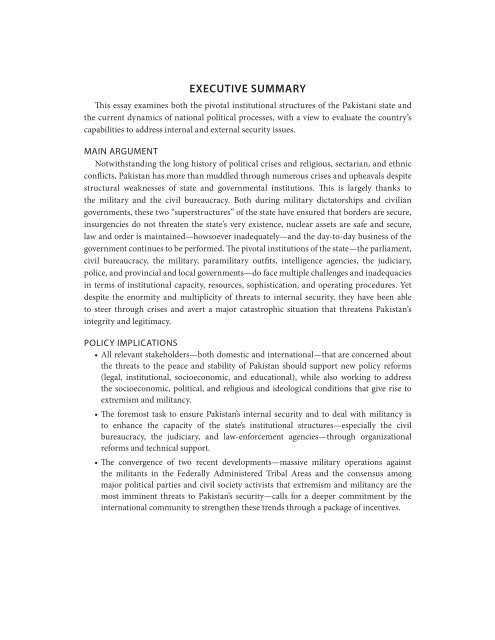pakistan’s
SR55_Mapping_Pakistan_February2016
SR55_Mapping_Pakistan_February2016
You also want an ePaper? Increase the reach of your titles
YUMPU automatically turns print PDFs into web optimized ePapers that Google loves.
EXECUTIVE SUMMARY<br />
This essay examines both the pivotal institutional structures of the Pakistani state and<br />
the current dynamics of national political processes, with a view to evaluate the country’s<br />
capabilities to address internal and external security issues.<br />
MAIN ARGUMENT<br />
Notwithstanding the long history of political crises and religious, sectarian, and ethnic<br />
conflicts, Pakistan has more than muddled through numerous crises and upheavals despite<br />
structural weaknesses of state and governmental institutions. This is largely thanks to<br />
the military and the civil bureaucracy. Both during military dictatorships and civilian<br />
governments, these two “superstructures” of the state have ensured that borders are secure,<br />
insurgencies do not threaten the state’s very existence, nuclear assets are safe and secure,<br />
law and order is maintained—howsoever inadequately—and the day-to-day business of the<br />
government continues to be performed. The pivotal institutions of the state—the parliament,<br />
civil bureaucracy, the military, paramilitary outfits, intelligence agencies, the judiciary,<br />
police, and provincial and local governments—do face multiple challenges and inadequacies<br />
in terms of institutional capacity, resources, sophistication, and operating procedures. Yet<br />
despite the enormity and multiplicity of threats to internal security, they have been able<br />
to steer through crises and avert a major catastrophic situation that threatens Pakistan’s<br />
integrity and legitimacy.<br />
POLICY IMPLICATIONS<br />
• All relevant stakeholders—both domestic and international—that are concerned about<br />
the threats to the peace and stability of Pakistan should support new policy reforms<br />
(legal, institutional, socioeconomic, and educational), while also working to address<br />
the socioeconomic, political, and religious and ideological conditions that give rise to<br />
extremism and militancy.<br />
• The foremost task to ensure Pakistan’s internal security and to deal with militancy is<br />
to enhance the capacity of the state’s institutional structures—especially the civil<br />
bureaucracy, the judiciary, and law-enforcement agencies—through organizational<br />
reforms and technical support.<br />
• The convergence of two recent developments—massive military operations against<br />
the militants in the Federally Administered Tribal Areas and the consensus among<br />
major political parties and civil society activists that extremism and militancy are the<br />
most imminent threats to Pakistan’s security—calls for a deeper commitment by the<br />
international community to strengthen these trends through a package of incentives.


